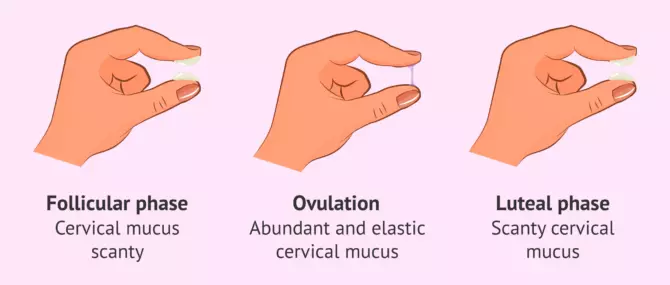Vaginal discharge is one of the symptoms that can indicate abnormal or normal problems. You should pay attention to the symptoms associated with vaginal discharge.
Vaginal secretions are produced from a small gland in the vagina and have various functions. These secretions indicate many things. In fact, by examining these secretions, we can find out a lot of information in the woman’s body. Also, many women’s diseases can be accompanied by vaginal secretions, knowing them helps to treat the disease.
In the following, we will examine the types of vaginal secretions that can be normal or abnormal. Each of the vaginal secretions has its own color, consistency and smell, which can possibly help in diagnosing the problem. Note that secretions alone cannot be decisive, and accompanying symptoms should also be considered.
What is vaginal discharge?
Vaginal discharge consists of fluid secreted from small glands in the vagina and cervix. Vaginal secretions play an important role in the reproductive system of women. The secretions made by the glands inside the vagina and cervix expel dead cells and bacteria out of the body. This keeps the vagina clean and helps prevent infection. Most of the time, vaginal discharge is completely normal.
The smell of secretions will change during pregnancy or if personal hygiene is not observed. None of these changes are danger signs. However, if the color, smell, or consistency of the discharge changes from normal, especially if you also have vaginal itching or burning, you may have an infection or other problems. Its quantity, smell and color can be different depending on where the person is in the menstrual cycle. For example, discharge increases during ovulation, breastfeeding, or sexual stimulation.
Vaginal discharge during the menstrual cycle
The secretions are different on different days of the menstrual cycle. Vaginal secretions are divided into before period, after and during period. Along with the events that happen to the uterus and ovaries, the vaginal secretions also undergo changes, which we will introduce below.
days 1 to 5; Vaginal discharge during period
At the beginning of the cycle, due to the shedding of the inner wall of the uterus, the discharge is usually red or bloody. Sometimes these secretions come out of the vagina in the form of dark brown powders, which means decomposed blood.

days 6 to 14; Vaginal discharge after period
After the end of menstruation, vaginal secretions become less than usual. As the egg begins to grow and mature, the cervical mucus secretions will become cloudy, white or yellow and may be sticky. This mucus is similar to slightly heated egg white.
days 14 to 25; Vaginal discharge after ovulation
A few days before ovulation, the discharge will be thin and slippery (like egg white). After ovulation, the discharge will again become cloudy, white, or yellow, and may be sticky.
days 25 to 28; Vaginal discharge before period
Before the start of the next menstrual period, cervical secretions become lighter and less. Therefore, what comes out of the vagina is in the form of unheated egg white.
Types of vaginal discharge
Vaginal discharge can be of different types. Different types of vaginal secretions indicate its normality and abnormality, and the amount of these secretions depends on the woman’s sexual cycle. If you want to know more about vaginal discharge, read the following carefully.
1. Colored vaginal discharge (types of vaginal discharge in terms of color)
In the following, we will introduce the types of vaginal secretions according to their color. Some of these explanations indicate infection, dryness, bleeding, and other issues that we will explain more about.
Red vaginal discharge
The range of red secretions can vary from light to dark and rust-like. Red discharge is due to bleeding during a menstrual period. The length of the menstrual cycle is 21 to 35 days (on average 28 days) and menstrual bleeding lasts 3 to 5 days.
Although bleeding between periods has benign causes, it is important to see a doctor if it occurs, as it can sometimes indicate serious issues. After a year without bleeding after menopause, if you see bleeding again, see a doctor because of the possibility of endometrial cancer.
Vaginal cheesy and white discharge
The range of white vaginal discharge is from cream to light yellow. If the person has no other symptoms, white discharge is normal. However, if the discharge is white, cheesy, or has a strong odor, it could indicate an infection and you should see a doctor. Note that discharges that indicate a fungal infection or candidiasis in a person are patchy and cheesy. On the other hand, they also cause itching and burning.
White, thick and smelly secretions, which can be accompanied by itching or burning, usually indicate a fungal infection.
Yellow vaginal discharge or green vaginal discharge
Pale yellow discharge is normal, especially when changing diet or using nutritional supplements. But dark yellow, greenish yellow and green discharges indicate bacterial infections or sexually transmitted infections. If you see secretions with thick and thick texture and with a strong bad smell, see a doctor immediately.
Pink vaginal discharge
Pink discharge can be light or dark pink and sometimes contain a small amount of blood. Pink discharge usually appears along with spotting at the beginning of the menstrual period. It can also be a sign of implantation in early pregnancy. Some people experience spotting when they ovulate, which can cause pink discharge. Pink discharge after sex can be seen due to tears or small scratches.
Clear vaginal discharge
Most daily vaginal discharge is clear or white and has a slimy texture similar to egg white. This type of discharge is seen during ovulation, sexual stimulation and pregnancy and is normal.

Gray vaginal discharge
Gray vaginal discharge is not normal and usually indicates a bacterial infection called bacterial vaginosis, which requires antibiotic treatment. In case of gray discharge, you should immediately go to the doctor. Symptoms of bacterial vaginosis include;
itching
Burning
strong smell
Redness around the entrance to the vagina
Colorless vaginal discharge
The vagina also has normal and colorless secretions. When your period ends, you enter a period where the uterine wall is being built. This period is called the estrogenic phase. Until ovulation, the uterine secretions that come out of the vagina are colorless and like egg whites that have not seen any heat. These secretions have a slightly mucoid consistency and are slightly sticky. But they are thinner than the secretions after the middle of the menstrual cycle and ovulation.
2. Normal vaginal discharge
The uterus is one of those organs that have glands that secrete their secretions into it. On the other hand, the uterine wall collapses. The outlet of the uterus opens into the vagina, and although the vagina itself does not have any secretory glands, it contains uterine secretions. So naturally, the vagina always has secretions.
Sometimes it is possible that some people have colored vaginal discharge and it is normal. The thing about vaginal secretions is that they should not cause discomfort and annoyance to a person.
Benefits of natural vaginal secretions
Natural vaginal secretions are necessary for the normal functioning of the body. We know that the vagina itself does not have any glands for secretion. Therefore, the interior of the vagina can be dry, which can cause discomfort during intercourse or in its normal state, which is contracted and contracted.
Uterine secretions can keep the vagina moist and balanced. These secretions are different in different periods of menstruation, and each one corresponds to the time when the ovaries and uterus are active. If the vagina did not secrete, during intercourse, the woman would experience dyspareunia or pain during intercourse, and sex would not be enjoyable at all.
On the other hand, vaginal secretions help maintain its natural flora and prevent infection. A vagina that is dry or has little discharge is at risk of fungal and bacterial infections. As in girls who have not yet reached the age of puberty or women who have gone through menopause, we can see this case.
3. Abnormal vaginal discharge
If the discharge is accompanied by any other symptom that is not normal and not seen routinely, it can be said that the discharge is abnormal. For example, the secretions are accompanied by vaginal body odor, or they are accompanied by burning and itching, spotting is seen, there are too many secretions, intercourse is painful, and many other disturbing things are seen with these secretions. In this case, we say that there are abnormal vaginal discharges.
You should consult a gynecologist for any problems related to vaginal discharge. You can get to know the best gynecologist in your city, consult them over the phone or online, and make an appointment for an in-person visit if needed.
4. Decreased vaginal secretions
The lack of vaginal discharge happens at some point in a woman’s life. When a woman approaches menopause, her vaginal discharge automatically decreases. This happens to many women. Usually, menopausal women suffer from vaginal dryness, and this is due to the thinning of the vaginal wall and its atrophy (loss of vaginal cells and its shrinking) and reduction of uterine secretions.
To solve the problem of these women, hormonal ointments such as estrogen ointment are usually used, which can also cause problems for women. Anyway, menopause is one of the periods of a woman’s life that must be passed.
The cause of vaginal discharge
Any change in the balance of natural vaginal bacteria can affect the smell, color or texture of discharge. In most people, infections or hormonal imbalances are responsible for unusual changes in vaginal discharge.
The following can disturb the balance of vaginal bacteria;
Use of antibiotics or steroids
Bacterial vaginosis; It is a bacterial infection that is more common in pregnant women or women with multiple sexual partners.
Contraceptive pills
Cervical Cancer
chlamydial or gonorrhea infections (STD); Sexually transmitted diseases
diabetes
Vaginal Infection
Vaginal douche, scented soap or lotions, scented substances that pour into the bathtub and foam.
Pelvic infection after surgery
pelvic inflammatory disease (PID)
trichomoniasis; It is a parasitic infection that usually results from having unprotected sex.
vaginal atrophy; Thinning and drying of the vaginal wall during menopause
inflammation of the vagina; Burning in or around the vagina
Fungal infection of the vagina
1. Vaginal discharge with vaginal odor
Sometimes vaginal discharge is accompanied by an unpleasant smell. As we mentioned before, only secretions cannot be a definitive factor to diagnose the problem. But if there are other symptoms besides discharge, the problem is different. One of the associated symptoms can be a bad smell from the vagina or a foul odor.
If there is a smell of dead fish with gray or green secretions (there may be other colors) in the vagina, there is a possibility of a bacterial infection. Therefore, you should go to a gynecologist to have a pelvic examination and, if necessary, a pap smear or other diagnostic tests will be taken from you.
2. Vaginal discharge during sex and after sex
The vagina must be moist for sex so that sex is possible and painless. Vaginal secretions are lubricating during sex and prevent vaginal dryness. These secretions before and during sex make the vagina moist and ready to accept the entry and movement of the male penis. On the other hand, after sex, vaginal discharge decreases and returns to its previous state. Vaginal secretions before and during sex are abundant, slimy and slightly acidic so that sperm can move in it and survive in a suitable environment.
3. When is vaginal discharge a sign of irritation?
Sexual stimulation of women is accompanied by symptoms, one of which is vaginal discharge. When a woman is stimulated, her vaginal discharge increases and makes the vaginal environment moist and slimy. The secretions are in the form that the lady gets wet. During stimulation, secretions are thinner and colorless.
4. Vaginal discharge in the first days of pregnancy
During pregnancy, vaginal secretions become more than normal, and this indicates the effect of pregnancy hormones on the uterus, which show themselves in the vagina. In the first weeks of pregnancy, watery secretions are seen. Two or three weeks after conception, blood or pink discharge is usually seen, which is a sign of the entry of the cell mass into the uterine wall. After that, white secretions with more consistency are usually seen.
The amount of discharge increases and the mother feels that her underwear is wet. As the gestational age increases, the amount of secretions increases. Also, the weight of the uterus increases and the pressure it puts on the bladder increases. Therefore, urinary incontinence is seen in women, and it is possible that clothes get wet due to urinating.
Vaginal discharge in the third week of pregnancy
One of the events that happens after conception is implantation. Usually, vaginal secretions change after implantation. As the egg cell begins to divide and moves through the fallopian tubes, it looks for a place to bite. This mass of cells is placed inside the uterine wall and goes inside it.
When this happens, the uterine wall becomes scarred and a hole is created. Making a hole in the blood-filled tissue of the uterus causes a little bleeding. This blood remains inside the uterus and decomposes a little, or it comes out at the same time and enters the vagina. When this blood comes out, we see bloody, brown or pale pink discharge in the vagina, and this happens in the second and third week of pregnancy.
Brown vaginal discharge in pregnancy
Brown secretions indicate bleeding or spotting. When a woman experiences spotting or bleeding, one should pay attention to the time of pregnancy. If there is brown discharge in the second and third week after fertilization, it is not a problem because it indicates implantation. But if the discharge is brown in the higher and later weeks of pregnancy, there is a risk of miscarriage or a threat of miscarriage. Therefore, necessary care and further investigations should be done. If necessary, take therapeutic measures.
5. Vaginal discharge after conception
After conception, we face the initial symptoms of pregnancy. One of these symptoms is vaginal discharge. When fertilization occurs, vaginal discharge changes. As we know, fertilization takes place inside the uterus (except for cases of ectopic pregnancy) and changes are seen in the uterus and ovaries. Therefore, the secretions seen in the vagina also change.
For example, immediately after implantation, which is approximately two weeks after conception, pink or bloody vaginal discharge can be seen. These secretions are due to the creation of a wound in the uterine wall and the implantation of the fertilized egg. After seeing the spotting that does not happen in some women, we see that the vaginal secretions get a firmer consistency.
6. Vaginal discharge with vaginal burning
Vaginal burning is one of the symptoms that you should see a gynecologist. If vaginal burning is accompanied by secretions, it can help in diagnosing the disease. For example, if vaginal burning is accompanied by bleeding or bloody discharge after intercourse, it indicates cervical and vaginal infections. These infections must be treated, because it gives us the message that the cervix is sore, which requires the examination of cervical cancer after treating the infection and inflammation.
If the burning of the vagina is accompanied by cheesy and white discharge, it can be a sign of a vaginal infection, probably of the fungal type and inflammation. One of the common symptoms of fungal infections is itching and burning.
If the burning of the vagina is accompanied by yellow and frothy secretions and a lot, it can indicate trichomonas vaginitis, which is accompanied by burning of the vagina and sometimes vaginal pain.
7. Vaginal discharge with vaginal itching
We have said many times that the most common symptom of vaginal yeast infection is vaginal itching. Therefore, seeing cheesy white secretions or even secretions that are egg white and accompanied by itching of the vagina, one can suspect candida.
8. The cause of excessive vaginal discharge
Sometimes changes such as trichomonas infections, which is a kind of beginning, the secretions increase dramatically. When the vaginal secretions are more than normal, further examinations should be done by the gynecologist. This infection has pain and redness, but the discharge is dirty and slightly yellow.
At other times, a lot of discharge is seen, which is usually due to events such as sexual stimulation, pregnancy, and other issues.
Treatment of vaginal discharge
Treatment depends on the cause of the disease. For example, a yeast infection is usually treated with antifungal medications that are applied in the form of a vaginal cream or gel. Bacterial vaginosis is treated with antibiotic pills or creams. Trichomoniasis is usually treated with metronidazole or tinidazole.
Some tips to prevent vaginal infection that causes abnormal discharge:
Keep the vagina clean by washing regularly with mild soap and warm water.
Never use scented soaps and feminine products or vaginal douches. Also, avoid feminine sprays and perfumed baths.
To prevent bacteria from entering the vagina and causing infection, always wash and dry the vagina from front to back.
Wear 100% cotton underwear and avoid clothes that are too tight.
When should we go to the doctor to treat vaginal discharge?
After reviewing your medical history and asking about your symptoms, the gynecologist will perform a pelvic exam and, if necessary, take a sample of discharge for further testing. If there is an abnormal smell or color in the vaginal secretions, or if you observe any of the following, see a doctor;
vaginal itching
Vaginal pain or any discomfort in this area
Cheesy or foamy discharge
Bleeding between periods or after menopause
Spotting after sex (repeatedly)
Gray, green or yellow discharge
Vaginal odor
vaginal burning
Burning sensation when urinating
Home treatment and traditional treatment of vaginal discharge
If you have a vaginal infection, you should see a gynecologist, but you can speed up its recovery with home remedies. Be aware that self-medication can hinder the healing process of vaginal infection and vaginal discharge and make it worse. For example, if the discharge is fungal, it means that the natural flora of the vagina has changed and can be cured by sitting in a mixture of water and apple cider vinegar. sat down and made it better.
Also, following nutritional recommendations can be effective in improving vaginal infection and secretions. For example, you should reduce the use of chocolate and sugar.
Another tip that is effective in home remedies for vaginal discharge is washing underwear and putting them in the sun. Exposing your underwear to the sun for 2-3 days can disinfect them. On the other hand, underwear should be thrown away after 6 months and new underwear should be purchased.
Home treatment of cheesy vaginal discharge
Cheesy vaginal discharge usually indicates a fungal infection. When you get a yeast infection, you can use some home remedies to treat these discharges. But remember that the main method of treating this disease is the use of drug therapy.
You can change your underwear and use cotton shorts.
Try to dry all your underwear under the sun or disinfect them with a hot iron.
Use more probiotic dairy products that can restore the beneficial microbes in the vaginal wall.
You can prepare a basin of warm water and dilute half a glass of white vinegar in it and sit in this basin. Sitting in this pelvis for 15 to 20 minutes can be very helpful.
Avoid eating chocolates and foods that contain sugar.
Vaginal washing with vaginal washing gel for vaginal secretions
Vaginal secretions are normal (as long as the characteristics that are said to be abnormal are not seen in the secretions), so washing the vagina should be done like the rest of the body. It is wrong to use a vaginal douche or a syringe to wash the inside of the vagina and observe women’s hygiene. Vaginal washing gel is one of the best and most suitable detergents for washing the vagina that does not disturb its flora and PH.
To wash the vagina, do not overdo it and every other day is the right time to wash it. If you bathe every day, daily vaginal washing with vaginal washing gel can be a good choice.





